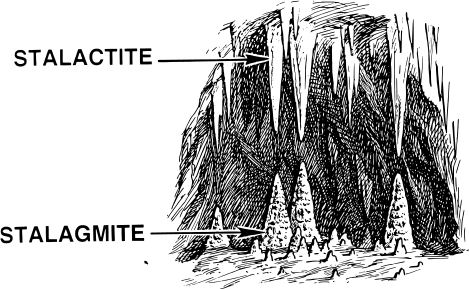Stalactite and stalagmite are two features found in a limestone cave. Stalactite is the cone shaped figure hanging from the roof of the cave and stalagmite is in a way a reflection of the stalactite, building its way towards the roof.
You've probably seen these in caves, but have you ever wondered how they are formed? Well, it all starts with a rain which has a slight acidic state; for example when the rain is mixed with the CO2 in the air, Carbonic Acid (H2CO3) is produced.
If this acidic rain comes into contact with the limestone, the acidic property will dissolve the stone in itself and start digging downwards until it has made a canal all the way through the thickness of the cave roof. This process might occur with one or several acidic rain falls; depending on the thickness of the roof and the acidic state of the rain.
The formula is:
Calcium Carbonate (Limestone) or CaCO3 + H2CO3 = Calcium Hydrogen Carbonate
Calcium Hydrogen Carbonate is a calcified liquid. Now, imagine a drop of this liquid on the very tip of the roof. Only a ring of this liquid will be solidified and concreted to the roof (later forming Stalactite) and the rest of that drop of liquid will be pulled towards the ground by gravity (later forming Stalagmite).
These drops will keep on coming down the route or canal and the same process will continue; meaning another ring will build up on the already existing one and so on. After many many years of rain and build up and solidification, the majestic figures of Stalagmite and Stalactite will take shape.
Though there is an important point hidden in the center of Stalactites. And that is the fact that the center of stalactites is hollow, because these figures are formed by the gathering of many rings of solidified calcium hydrogen carbonate. But, there comes a stage where a drop of the liquid comes rolling down the tunnel which the rings have formed and for some reason, a ring isn't formed and instead the whole drop solidifies, closing the tunnel.
The following drops will come in through the tunnel, but will reach a dead end and will completely solidify. Till this stage, the figure (stalactite) is a rough cylinder. But when the hollow tunnel in the middle of the stalactite is filled, the following drops will drip to the sides. This is the reason that older stalactites are a fine coned shape.
Sometimes the stalactite and stalagmite will touch each other and join up, forming what is called a "column".
A precaution on your adventure in a cave with stalactites and stalagmites is not to touch the figure as the sweat on the palms which contains a slight fraction of lipids, can smother on to the features, change the route of the calcified droplets and overall the natural shape of the figure.




No comments:
Post a Comment